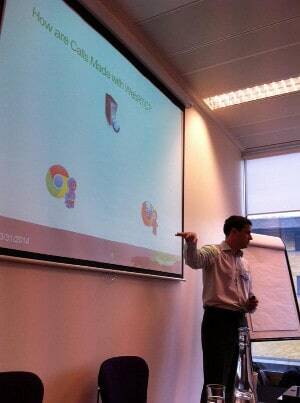Less than a hundred miles from the rim of the Hoover Dam, just outside of Las Vegas at the edge of dusty San Bernardino County, sits a symbol of how the sun will some day provide copious amounts of electricity for entire cities. This is Ivanpah, the world’s largest operating solar farm, which uses 347,000 mirrors (173,500 heliostats) and three huge 450-foot towers to harness the sun’s heat to generate electricity.
As of the beginning of this year, it’s a mere symbol no longer. After more than seven years of development, over three years of construction, 2,700 workers, and $1.6 billion in U.S. government loan money, the massive solar farm is finally live and sending enough solar power into the grid to power 140,000 (average American) homes. Ivanpah was officially launched on Thursday with an event that featured U.S. Secretary of Energy Ernie Moniz, David Crane, the CEO of Ivanpah’s majority owner power company NRG Energy, and members of the band The Fray, which filmed a video at Ivanpah and titled their latest album Helios. Oh, and of course, a lot of media people, too.
To the workers, the companies (including Google and startup BrightSource) and the federal and state groups involved in supporting the 5-mile by one-mile long colossal clean power project, Ivanpah is the Hoover Dam for this generation. In fact, Bechtel, which helped build the Hoover Dam in the 1930s, also led the construction of Ivanpah.
More than anything, the facility marks a future of emerging clean power options that can begin to compete with large scale fossil fuel power, but without the associated carbon emissions. Ivanpah is an early example of how next-generation technology, innovation, entrepreneurialism and government support can come together to provide solutions to climate change in a substantial way.
In the beginning
Ivanpah originally began as an idea for the first commercial-scale project from a tiny startup based in Oakland, Calif., and Israel called BrightSource Energy. Founded in 2004 by the original developers of the Luz solar projects, which were built in the Mojave desert in the 1980s and 1990s (the company later went bankrupt), BrightSource emerged as one of the more promising startups out of the Silicon Valley cleantech bubble.
BrightSource was funded early on by the Valley’s VantagePoint Capital Partners, and one of VantagePoint’s team, John Woolard, joined BrightSource as the original CEO. Woolard spent years pushing BrightSource’s technology forward and wading through the regulatory process needed to get projects like Ivanpah (built on public land) permitted. He’s still the chairman, though he handed the CEO reigns to David Ramm in late 2013.
Ivanpah took years longer to get built than expected. It was one of the first projects to be developed on controversial Bureau of Land Management land, and the location ended up having more desert tortoises than originally thought. It’s been an object of much environmental scrutiny and at one point the site employed 160 biologists to try to make sure the handful of tortoises that live there weren’t disturbed.
BrightSource also ended up needing a lot of capital to get both its early demo plants and Ivanpah up and running. BrightSource raised hundreds of millions of dollars from investors included DBL Investors, Morgan Stanley, Draper Fisher Jurvetson, BP, Chevron, Alstom, Black River, and Statoil HydroVentures. BrightSource put up the first money into Ivanpah, but turned to partners to put up the rest.
As BrightSource made more progress with smaller demo solar plants like its one in partnership with Chevron in Coalinga, Calif., the company was able to secure some larger investors and partners behind Ivanpah. Bechtel came on to support Ivanpah in 2009 (as both an equity investor and builder), and NRG Energy took a majority share of the project with a $300 million investment in 2010.
Google even put in $168 million in 2011. Google is interested both in the financial return that a 25-year power contract can deliver, and also that it’s interested in backing clean power for its data centers both directly and indirectly.

The solar mirrors at Ivanpah spell out the word Google, a backer of the project. A view from the 6th floor of tower Unit 1.
Then of course, utilities PG&E and SCE have stepped in to become the customers for Ivanpah as they looked to meet aggressive state mandates that say utilities need to provide a certain amount of their electricity from clean sources. Without these California state mandates there would be no Ivanpah.
Finally there was the federal government and the Obama administration’s plan to use loan guarantees as a way to stimulate large job-creating projects. While the loan guarantee program was controversial because it gave money to companies like Solyndra and Fisker, it also gave $1.6 billion to Ivanpah. NRG Energy’s CEO David Crane said on Thursday that the project “unequivocally and without doubt” would not have been built without that loan.
Cleantech stories
But like so many cleantech stories, BrightSource struggled along the way. The company filed to go public in the spring of 2011, but a year later pulled that IPO after the public markets and the solar industry saw dark times. An IPO would have provided BrightSource’s investors an exit when it went public. Later VantagePoint Capital Partners was unable to raise its next fund due to lack of returns on the cleantech fund that backed BrightSource and many others.
BrightSource also shifted its strategy from building solar farms like Ivanpah to providing the technology for those solar farms, and having deep-pocketed power companies own and operate the farms. That strategy seems to be working now, and is a common transition for Silicon Valley-backed cleantech companies.
BrightSource is the latest example of a cleantech company that might not have made its venture capital backers money (at least not yet) but is now delivering disruptive and world-changing technology to the commercial markets. BrightSource has a pipeline of projects it wants to get built both in the Mojave and also internationally in South Africa, China and the Middle East.
Solar heat
Ivanpah is using markedly different solar technology than the type used by solar panels installed on rooftops. Solar panels directly convert light into electricity. Average panels convert about 10 percent to 12 percent of the light, while more high efficiency panels like those from SunPower convert about 20 percent.
Ivanpah uses solar thermal and tower power technology. That’s essentially a big field of mirrors that track the sun throughout the day and focus the sunlight up to the top of the boilers on top of the three towers throughout the field. It’s like if you’ve ever focused a magnifying glass on a leaf or an ant when you were a kid — power that up hundreds of thousands of times and you’ve got a pretty powerful energy source.
The boilers turn bright white as they reach 1,000 degrees Fahrenheit and generate steam (as opposed to black when off). The steam operates a steam turbine which produces electricity. Unlike other solar thermal or fossil fuel power plants, Ivanpah uses dry cooling instead of water cooling to manage its heat. That’s important because as we’ve seen with the California drought, the future will be increasingly water-constrained.
Connectivity and computing is playing a role in Ivanpah as well. Each heliostat is connected by not only a power cable but also a data cable that controls each one ensuring they track the sun, or change position according to the facilities’ needs. When there are high winds the mirrors go into a safety flat position. When it rains they also go into that position to get a free mother nature washing. Data commands all aspects of the Ivanpah facility.
The future of solar thermal
Now that Ivanpah is fully built and constructed, the ironic part is that the technology is actually already dated. BrightSource’s CEO Ramm said during the media event on Thursday that future BrightSource projects will likely be 30 to 40 percent cheaper. That cost reduction will be because of efficiencies delivered in scaling up the technology, like moving from data cables to wireless data connections for the mirrors.
BrightSource will also focus future projects on moving from steam boilers to molten salt boilers, which can hold energy and store it during needed times like in the middle of the night. Storage will be increasingly important to make solar thermal a viable technology now that solar panels have dropped in price so dramatically.
Solar panels are actually the elephant in the room when it comes to a technology like Ivanpah’s. Over the seven years that it took Ivanpah to get permitted and built, solar panels are now at their cheapest time in history, and large solar panel projects are being built at scale, too. Solar thermal projects needed to provide something extra to compete at cost with both solar panel projects and fossil fuel power plants.
While Ivanpah might be the first of its kind, it represents the emergence of a solar power technology that can reach the kind of scale that a coal or natural gas plant can. Distributed solar panels on rooftops are disruptive to be sure, but in the near term utilities are looking for large power sources that can help them meet their mandates and that operate 24/7, like fossil fuel plants do.
While Ivanpah might not be perfect — it’s taken years and it’s more expensive than future projects — it’s also a symbol of how next-generation technology can deliver solutions to climate change at a scale that can compete with the incumbent technologies. It shows how Silicon Valley cleantech companies and entrepreneurs might not fit into the traditional venture capital model, but they’re continuing to bring disruptive technology to market that can change the energy game.
Related research and analysis from Gigaom Research:
Subscriber content. Sign up for a free trial.
- Key steps for successful renewable-energy permitting
- A 2011 Green IT Forecast
- The growth and promise of the LED market



















 The typical workflow in the enterprise spans multiple applications. But in the age of mobile computing it’s not always as easy as it should be to craft a workflow that spans multiple applications. Moving to address that specific issue
The typical workflow in the enterprise spans multiple applications. But in the age of mobile computing it’s not always as easy as it should be to craft a workflow that spans multiple applications. Moving to address that specific issue 

















